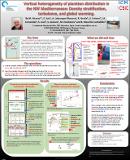Por favor, use este identificador para citar o enlazar a este item:
http://hdl.handle.net/10261/125183COMPARTIR / EXPORTAR:
 SHARE
BASE SHARE
BASE
|
|
| Visualizar otros formatos: MARC | Dublin Core | RDF | ORE | MODS | METS | DIDL | DATACITE | |

| Título: | Vertical heterogeneity of plankton distribution in the NW Mediterranean: Density stratification, turbulence and global warming |
Autor: | Alcaraz, Miquel CSIC ORCID; Saiz, Enric CSIC ORCID ; Isari, Stamatina CSIC ORCID; Zamora, Sara CSIC ORCID; Emelianov, Mikhail CSIC ORCID ; Lebourges-Dhaussy, A.; Graña, Rocío; Mouriño-Carballido, Beatriz; Cotano, Unai; Fernandes-Salvador, José A. | Fecha de publicación: | 16-nov-2014 | Citación: | 2nd International Ocean Research Conference (2014) | Resumen: | The depth distribution pattern of plankton biomass in relation to vertical gradients of physical and chemical variables was studied during a 5-day time series at a fixed station in the Catalan Sea (NW Mediterranean). Our objective was to improve our understanding of the control exerted by oceanographic characteristics on the matter and energy transfer in marine pelagic ecosystems. The study took place during the summer stratification period and included CTD profiles of temperature, salinity, O2 and fluorescence (as a proxy of phytoplankton concentration), and turbulence microstructure obtained with a MST® profiler. The 5-200 m depth fine-scale vertical distribution of organisms (particles) ranging from 100 µm to 4 mm ESD was obtained with a TAPS® (high resolution acoustics, 6 frequency channels), and samples to study the vertical micro- and mesozooplankton distribution were taken with a LHPR® net fitted with 50 and 200 μm-mesh gauzes at 15 depth-strata. A clear deep phytoplankton (fluorescence) maximum layer was located at the base of the thermocline, accompanied during daylight hours by sharp micro- and mesozooplankton maximum biomass layers that coincided with enhanced values of dissipation rates of turbulent kinetic energy (ε). During the night the integrated mesozooplankton biomass was higher but dispersed and its maximum was shallower. While pycnocline depth and microturbulence intensity can be modified by ocean warming, photoperiod (and probably light intensity) will not be affected by the future global changes, and the properties of the deep plankton layers as a food hotspot can be significantly altered | Descripción: | 2nd International Ocean Research Conference, One planet one ocean, 17-21 November 2014, Barcelona, Spain | Versión del editor: | http://www.iocunesco-oneplanetoneocean.fnob.org/ | URI: | http://hdl.handle.net/10261/125183 |
| Aparece en las colecciones: | (ICM) Comunicaciones congresos |
Ficheros en este ítem:
| Fichero | Descripción | Tamaño | Formato | |
|---|---|---|---|---|
| Alcaraz_et_al_2014_poster.pdf | 8,07 MB | Adobe PDF |  Visualizar/Abrir |
CORE Recommender
Page view(s)
245
checked on 16-abr-2024
Download(s)
49
checked on 16-abr-2024
Google ScholarTM
Check
NOTA: Los ítems de Digital.CSIC están protegidos por copyright, con todos los derechos reservados, a menos que se indique lo contrario.
